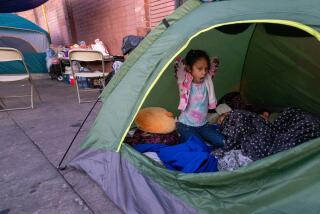Meeting People on Their Home Turf
LANCASTER, Pa. — The kids, dressed in trendy board shorts and sandals, put down their CD players and stepped out of the minivan into another century. There, outside the farmhouse, they saw longhaired little girls wearing plain, solid-colored dresses up to their necks--no tank tops or shorts despite the summer heat--giving one another rides on a simple wooden wagon. Older boys wearing dark pants, long-sleeved shirts and straw hats were tinkering with handmade birdhouses they hoped to sell. All were barefoot.
The two groups of youngsters eyed each other curiously. My friends and I had brought five of our children, ages 5 to 11, to this Amish farm outside Lancaster for just this experience. We wanted our kids to get a look at a way of life far different from their own.
On this summer night, we’d be having dinner in a small Amish home, along with two dozen other interested outsiders from around the world--Spain, Saudi Arabia and Ireland--who had found their way down this rural road.
“Welcome,” our 72-year-old host greeted us heartily as he ushered us to a round table in the living room. His 68-year-old wife, her cheeks flushed from cooking, was busy serving platters of turkey, ham, potatoes and noodles. The food was simple and plentiful.
Our hosts had no problem with my writing about our evening, as long as I didn’t use their names or take photographs. They believe that would be too “prideful,” though they are eager nonetheless to encourage their small dinner business.
Our kids noticed immediately our hostess’ distinctive garb: Her dark blue dress was fastened with pins rather than zipper or buttons. She wore a white prayer cap. The Amish believe such clothes encourage humility.
The house had no electricity. The stove and refrigerator were powered by propane; the running water came from a water wheel. The kids were amazed that families could live without TV, telephones, VCRs and computers. “We don’t miss them,” our host told the children.
The youngsters outside were his grandchildren, we learned. They live across the road and attend a one-room school. They will quit after eighth grade to help their parents. Ours were wide-eyed at that notion and couldn’t wait to finish their food so they could go out to play with them. Meanwhile, our hostess was equally intrigued by the young Saudi couples’ descriptions of arranged marriages.
Two decades ago, such an evening would have been unthinkable, local experts say. The Amish, whose roots date back more than 300 years to Europe, traditionally have eschewed contact with outsiders, turning their backs on photographers who, they felt, were invading their privacy.
But that has begun to change, at least around Lancaster County, where about 4 million tourists visit each year, drawn by the thriving Amish community, 18,000 strong. Quietly and with the help of local B&B; owners, a dozen or more Amish farmers have opened their homes to tourists for regularly scheduled meals. They charge about what a small country restaurant would, $13 for the meal we had, half-price for kids.
“They’ve begun to see tourism as a livelihood at a time many can’t earn enough farming,” said Wes Newswanger, a spokesman for the Mennonite Information Center, which serves also as a resource on the Amish.
While these dinners are not formally sanctioned by local officials or licensed by the state, no one seems to want to disrupt the growing practice. “We certainly believe folks should live the Amish experience as much as possible,” said Michael Lukens, a spokesman for the Pennsylvania Department of Community and Economic Development, which oversees tourism.
For more information about the Amish or these dinners, call (717) 299-0954, Internet https://www.mennoniteinfoctr.com (at which you will find an e-mail address). Local B&Bs; also can help. Call the Pennsylvania Dutch Convention and Visitors Bureau at (800) PA-DUTCH (723-8824) or Internet https://www.800padutch.com.
Other heavily trafficked tourist destinations have initiated similar programs with the same goal--to give outsiders a more intimate and realistic view of their culture.
Visitors to Jamaica, for example, can “Meet the People” through a government program in which they are matched with locals of similar interests and lifestyles. About 700 volunteers participate.
Hundreds of volunteers host tourists in the Bahamas’ popular and free “People-to-People” program. “Our guide met us at the ship and spent the day with us in Nassau,” said Katrina Tyson, who saw a reference to the program on the Web while at home in Cleveland. “We got a much better sense of what the island was like than on a boring tour. And it was free.”
For information about the Bahamas program, call (242) 356-0435 or Internet https://www.bahamas.com. For Jamaica, call (800) JAMAICA (526-2422) or Internet https://www.jamaicatravel.com.
If this is something that appeals to your family, wherever you travel, see if you can arrange a family visit. Ask the local tourism office or your hotel concierge. B&Bs; can provide the first step, as can local tour guides who pride themselves on helping travelers get off the tourist track.
Taking the Kids appears the first and third week of every month.


